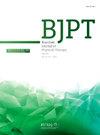What are physical therapists doing to prevent falls in older adults in Brazil? - Findings from a nationwide survey
IF 3.2
3区 医学
Q1 ORTHOPEDICS
引用次数: 0
Abstract
Background
Understanding how physical therapists (PTs) approach fall prevention in older adults and factors that may influence their clinical practices is essential for designing knowledge translation strategies.
Objectives
To describe PTs’ clinical practices and barriers to implementing fall prevention best practices in older adults and to identify professional characteristics associated with implementation of fall prevention best practices.
Methods
A cross-sectional online survey was conducted. Registered PTs providing care to older adults were recruited through social media platforms. A pre-tested questionnaire assessed clinical practice patterns, sociodemographic and professional characteristics, and behavioral factors influencing the implementation of fall prevention best practices. Data were analyzed descriptively, and multinomial regression identified associations between PTs’ characteristics and practice frequency. The Theoretical Domains Framework and the Capability, Opportunity, Motivation-Behaviour model guided questionnaire design and interpretation of findings.
Results
Among 454 PTs surveyed, over 65 % reported frequently (often or always) asking patients about falls, identifying and documenting fall risk factors, and implementing fall prevention interventions. Recommended practices such as balance and strength training were commonly implemented. Barriers to fall prevention best practices included patient denial of risk, reluctance to report falls, and adherence challenges. PTs not practicing in geriatrics or those lacking up-to-date fall prevention knowledge were less likely to report consistent use of best practices.
Conclusion
Brazilian PTs frequently integrate fall prevention into older adult care but face patient-related barriers. Addressing the identified barriers through behavior change strategies could enhance the implementation of fall prevention best practices.
在巴西,物理治疗师如何预防老年人跌倒?——一项全国性调查的结果
了解物理治疗师(PTs)如何预防老年人跌倒,以及可能影响其临床实践的因素,对于设计知识转化策略至关重要。目的描述老年人PTs的临床实践和实施跌倒预防最佳实践的障碍,并确定与实施跌倒预防最佳实践相关的专业特征。方法采用横断面在线调查方法。通过社交媒体平台招募为老年人提供护理的注册PTs。一份预测问卷评估了临床实践模式、社会人口统计学和专业特征以及影响实施预防跌倒最佳实践的行为因素。对数据进行描述性分析,多项回归确定了PTs特征与练习频率之间的关联。理论领域框架和能力、机会、动机-行为模型指导问卷设计和研究结果的解释。结果在接受调查的454名PTs中,超过65%的PTs报告经常(经常或总是)询问患者有关跌倒的情况,识别和记录跌倒的危险因素,并实施预防跌倒的干预措施。推荐的练习,如平衡和力量训练,被普遍采用。预防跌倒最佳实践的障碍包括患者否认风险、不愿报告跌倒和坚持挑战。没有从事老年医学实践或缺乏最新跌倒预防知识的PTs不太可能报告持续使用最佳实践。结论巴西PTs经常将预防跌倒纳入老年人护理,但面临患者相关障碍。通过行为改变战略解决已确定的障碍,可以加强预防跌倒最佳做法的实施。
本文章由计算机程序翻译,如有差异,请以英文原文为准。
求助全文
约1分钟内获得全文
求助全文
来源期刊
CiteScore
6.10
自引率
8.80%
发文量
53
审稿时长
74 days
期刊介绍:
The Brazilian Journal of Physical Therapy (BJPT) is the official publication of the Brazilian Society of Physical Therapy Research and Graduate Studies (ABRAPG-Ft). It publishes original research articles on topics related to the areas of physical therapy and rehabilitation sciences, including clinical, basic or applied studies on the assessment, prevention, and treatment of movement disorders.

 求助内容:
求助内容: 应助结果提醒方式:
应助结果提醒方式:


